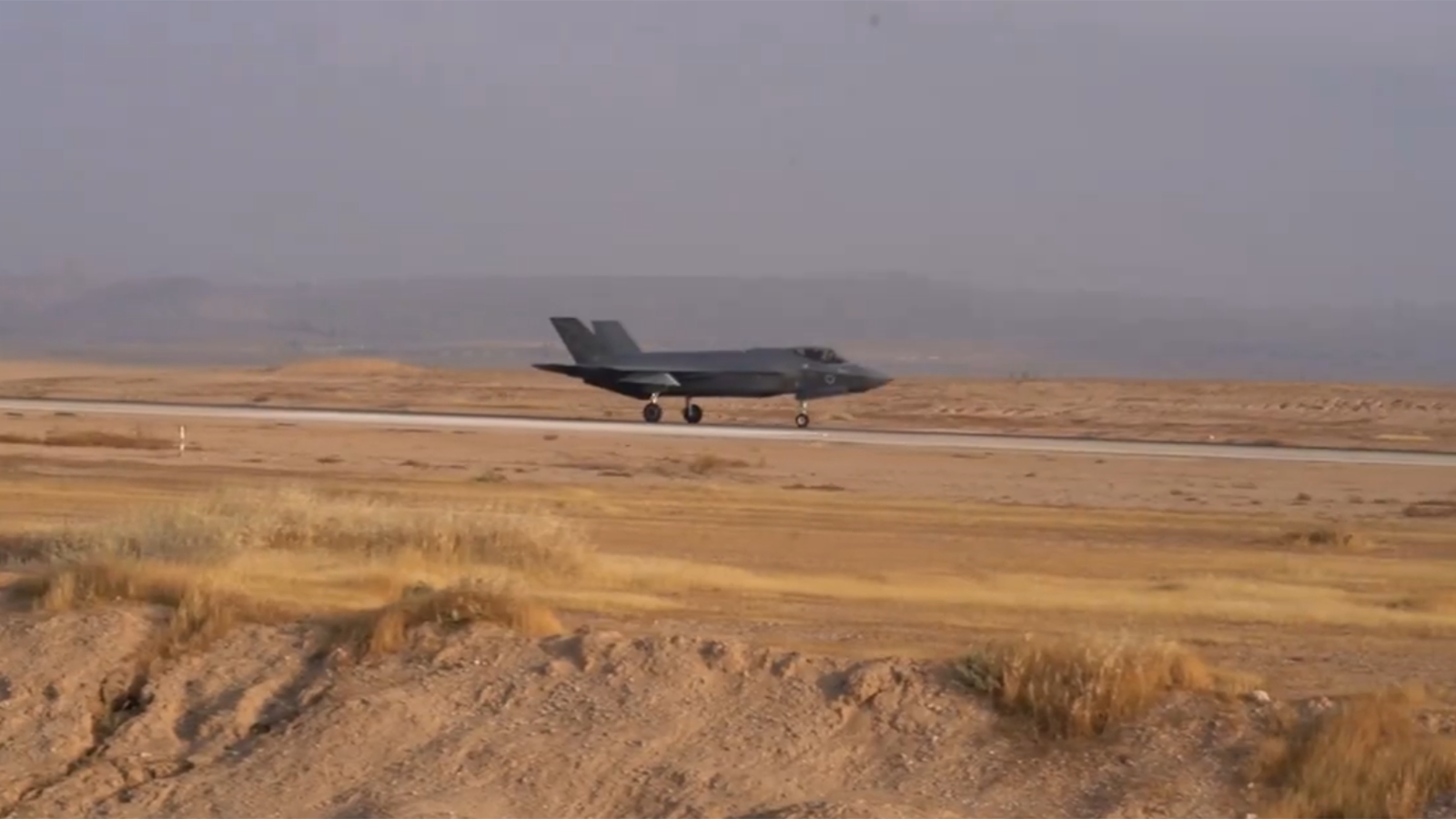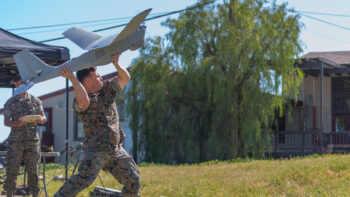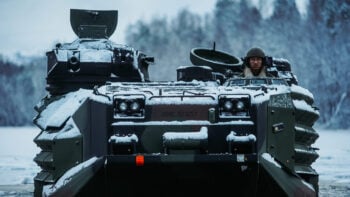
A screengrab from a video posted online by the IDF purporting to show an F-35I Adir fighter jet returning to Nevatim Airbase on April 14, 2024. (IDF via X)
JERUSALEM — Iran may have specifically targeted an Israeli airbase housing F-35 fighter jets during its unprecedented missile and drone attack on Israel over the weekend, but few of the munitions made it to the target and none appear to have done significant damage, Israeli military officials said today.
On Sunday, Iranian Foreign Minister Mossein Amirabdollhian said Tehran took aim at only military targets in its “limited” strike, including an Israeli facility that housed F-35 fighters, apparently in retaliation for the F-35s’ purported role in the Damascus strike on April 1 that killed several senior Iranian military and intelligence officials. A senior Iranian military official, Armed Forces Maj. Gen. Mohammad Bagheri, specifically said Israel’s Nevatim Airbase in southern Israel was targeted, according to local media.
But today Israeli Defense Forces said that though Nevatim was indeed targeted, Iran failed to cause any major damage there on Saturday night. Emphasizing the point, the IDF released footage of an F-35 landing at Nevatim just hours after the attack, and IDF Chief of Staff Herzi Haveli chose to make a speech there with a pristine F-35 looming in the background today.
הרמטכ״ל, רב-אלוף הרצי הלוי, ביקר היום בבסיס נבטים עם מפקד הבסיס, תת-אלוף יותם סיגלר.
במהלך הביקור, סייר הרמטכ״ל בטייסת האדיר 140 וקיים שיח עם צוותי האוויר והמפקדים בטייסת, שלקחו חלק בסיכול ויירוט המתקפה האיראנית נגד ישראל במסגרת מבצע ״מגן ברזל״>> pic.twitter.com/FFgc6zUK5b— צבא ההגנה לישראל (@idfonline) April 15, 2024
“Iran wanted to harm the strategic capabilities of the state of Israel, this is something that did not happen in the past,” Haveli said, speaking to members of the IDF’s 140th Squadron, which flies the fifth-generation fighter. But, he said, Iran had run up against Israel’s “air superiority.”
Still, at least a few munitions got through. An image from the base showed an impact crater in an open area, and footage the IDF released showed a crew repairing an area that was apparently impacted by a missile. Additional IDF footage released on April 15 showed limited “damage from an Iranian missile [to] construction infrastructure at the Nevatim Airbase.”
Watch the F-35I Adir fighter jets return to Nevatim Airbase after successfully protecting Israel’s airspace: pic.twitter.com/ap5gPLphPD
— Israel Defense Forces (@IDF) April 14, 2024
ABC News reported that a senior US official said that Nevatim was hit by five ballistic missiles, damaging a C-130 transport aircraft, an unused runway and empty storage facilities. IDF spokesperson Rear Adm. Daniel Hagari said today that only four missiles hit the base area.
“Out of hundreds of launches, only a few missiles crossed into the territory of the State of Israel causing only minor damage to infrastructure at the Nevatim Airbase near the runway and to a road in the Hermon area,” the IDF said on April 14. “The functionality of the Nevatim Airbase was not affected, aircraft continued to take off and fulfill their defense and offense missions — even during the night, and throughout the day.”
In all, Iran lobbed approximately 350 threats towards Israel, about half of them drones and the other half missiles, but beyond grave injuries to a child, no major casualties have been reported. US officials said that an estimated 99 percent of the munitions were intercepted before they reached their targets.
Israel dubbed its defensive mission “Iron Shield,” and many of the interceptions were credited to its famed air defense system, led by the Arrow system. US, British and Jordanian forces played roles in intercepting incoming drones and missiles as well, officials said. For instance, US naval ships downed several ballistic missiles, and US Central Command said it downed 80 drones.
Defense of Israel Activities Update
On April 13 and the morning of April 14, U.S. Central Command (CENTCOM) forces, supported by U.S. European Command destroyers, successfully engaged and destroyed more than 80 one-way attack uncrewed aerial vehicles (OWA UAV) and at least six… pic.twitter.com/QYyk01o1Vs
— U.S. Central Command (@CENTCOM) April 14, 2024
The IDF also said that it had deployed dozens of aircraft to intercept the incoming threats. Israel operates F-15s and F-16s, which can be armed with Python 5 air-to-air missiles which can be used to down drones. In addition, Israel has 39 F-35I Adir warplanes, out of 75 it as on order. Several F-35 squadrons operate at Nevatim, including the 140 “Golden Eagle” Squadron, the 117th training squadron, which was reopened in 2021, and the 116th “Lions of the South” Squadron, which opened in 2020 as the second F-35 squadron.
The large base also includes a plethora of other aircraft. It is home to Israel’s C-130 Super Hercules ‘Elephants’ squadron, as well as a squadron that operates the older C-130s. (It’s unclear which of those was reportedly struck.) It is also home to the Israel’s Eitam and Oron special mission aircraft, as well as the new Wing of Zion Israeli government transport aircraft.
Marines new ‘Fusion Center’ aimed transitioning cutting edge tech more smoothly
Marine Corps officials said the new office will act as a bridge over the Pentagon’s infamous “valley of death” and will first focus on counter-drone systems.


























